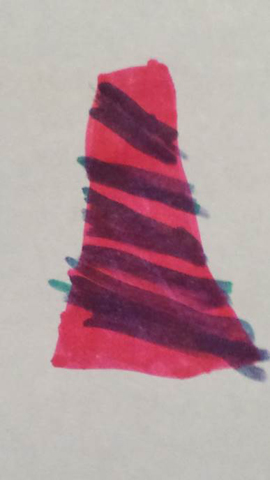
Olive's drawing (Photo courtesy of Olive's mother "Margie")
Every once in a while something really special comes across my inbox. Recently a friend who teaches theology, "Margie," sent me this story about her 5-year-old daughter Olive.
For kindergarten homework, Olive was assigned to draw pictures of things that begin with the letter "G." When she came home she proudly displayed drawings of a ghost, a garage and her grandpa.
But a fourth picture was not so easily identifiable, so my friend asked Olive what it was supposed to be.
"She informed me that it was a picture of God," said Margie. "I asked her to explain, and here's what she said:
'Well, nobody knows if God is a boy or girl, and nobody knows what God looks like. I think God is a girl. But I still don't know what She looks like. So I just drew the dress.'"
After my delighted laughter subsided, I found myself filled with gratitude that a young girl-child was able to envision God as someone who looks like her, even to the point of designing a red- and blue-striped dress for God to wear.
Wow. Such a profound thought process for a five-year-old -- even for one with a theologian for a mother.
I wonder how many other children are ok with not knowing whether God is a boy or a girl. For that matter, I wonder how many adults are ok with recognizing that God is not a boy's name.
I'm guessing not very many.
Theologian Elizabeth Johnson's seminal book, She Who Is, masterfully addressed the profundity of the God mystery and why it is appropriate to address God with female pronouns as well as male pronouns. Throughout her book, Johnson honors Catholic theological tradition by pointing to the reality that, in the end, all language about God is metaphorical.
This means, that like Olive's dress, no one word, phrase or attribute can ever fully describe God or exhaust all there is to know and love about a God who is at once ultimate mystery but very close to us. Diversifying our God imagery can help us access and more fully appreciate the divine love-energy that alone fills and frees us.
And so we see Jesus evoke the love of a mother hen protecting her brood, as he weeps in frustration over Jerusalem, (Mt 23: 37). And we watch the Hebrew people acclaim Holy Wisdom:
...[F]or Wisdom is quicker to move than any motion; she is so pure, she pervades and permeates all things. She is a breath of the power of God, pure emanation of the glory of the Almighty; hence nothing impure can find a way into her. She is a reflection of the eternal light, untarnished mirror of God's active power, image of God's goodness. (Wisdom 7: 24-26)
While all of this may seem a bit esoteric, it is not. Exclusively male language for God has profound consequences. Always naming God in male-domination-superior metaphors such as king, lord, father or master effectively reduces God to an idol and implies that men are born to rule and women to obey.
Introducing alternative language such as "indwelling spirit," "just one," "ultimate compassion" or "strong mother," for example, not only enriches our relationship with God but, as Johnson notes in her book Quest for the Living God, it honors the truth and creates conditions for equality:
... [S]eeking the female face of God has profound significance. By relativizing masculine imagery it lassoes the idol off its pedestal, breaking the stranglehold of patriarchal discourse and its deleterious effects. God is not literally a father or a king or a lord but something ever so much greater. Thus is the truth more greatly honored. ... If God is 'she" as well as "he" -- and in fact neither -- a new possibility can be envisioned of a community that honors difference but allows women and men to share life in equal measure. (p. 98-100)
Changing exclusively patriarchal language about God may or may not help men to value women, but it will surely help women to value themselves.
Gender-balanced language about God can catalyze efforts to eliminate pervasive gender inequality that leads to so much poverty, sexual violence and female income and educational deficits. Women working full-time jobs still earn only 77% of what their male counterparts make, and some 62 million of the world's girls are denied an education.
But back to Olive. What I love is that she felt perfectly free to think of God as a girl [like her] even though she understands "no one knows what God looks like."
Her simplicity is instructive.
No one knows what God looks like.
But that should never stop us from envisioning what God looks like or who God might be for each of us, so long as we remember that our images are like Olive's dress -- enriching, important, and nourishing but neither exclusive nor the final word.
God is just so much bigger and more beautiful than anything we can imagine.
As for Olive, well she is clearly destined for great things -- perhaps a famous theologian or maybe a gifted designer for Project Runway.
I'd like to take a cue from Olive and design a bunch of different dresses for God.
It would be so much fun to watch Her rock the runway.
[A Sister of St. Joseph, Sr. Christine Schenk served urban families for 18 years as a nurse midwife before co-founding FutureChurch, where she served for 23 years. She holds master's degrees in nursing and theology.]
Editor's note: We can send you an email alert every time Christine Schenk's column, Simply Spirit, is posted. Go to this page and follow directions: Email alert sign-up.




